Coat of arms of Etruria: Difference between revisions
| Line 68: | Line 68: | ||
|1790-1810 | |1790-1810 | ||
|- | |- | ||
| rowspan=" | | rowspan="2" | [[United Kingdom of Etruria]] | ||
|align="center" | [[File:UKEcoatofarms.png|120px]] | |align="center" | [[File:UKEcoatofarms.png|120px]] | ||
|The coat of arms adopted by the [[United Kingdom of Etruria]] in wake of the [[Caltrini Restoration]] in 1810, was markedly different to other coats of arms found in monarchies across [[Euclea]]. In an effort to pay homage to the republicanism of the Revolution and to deter opposition to the return of monarchism, the new coat of arms was absent of any reference to the [[House of Caltrini]]. Instead, the coat of arms adopted symbols of key regions of the Kingdom. The shield is comprised of from top-left clockwise: the Keys and parasol of [[Solaria]], to reflect its Papal history, the crowned sea dragon of the [[Solarian Sea]], the winged lion of [[Povelia]], wearing a {{wp|phyrgian cap}}, the historic coat of arms of [[Novalia]] and the crowned eagle of [[Carinthia (Etruria)|Carinthia]]. At the centre is a shield containing an image of the {{wp|Virgin Mary}} to reflect the country's [[Solarian Catholic Church|Catholicism]]. Some verions of the emblem include the Crown of Saint Vittore, though this was used solely for royal correspondence or documents and was never displayed publicly. Between | |The coat of arms adopted by the [[United Kingdom of Etruria]] in wake of the [[Caltrini Restoration]] in 1810, was markedly different to other coats of arms found in monarchies across [[Euclea]]. In an effort to pay homage to the republicanism of the Revolution and to deter opposition to the return of monarchism, the new coat of arms was absent of any reference to the [[House of Caltrini]]. Instead, the coat of arms adopted symbols of key regions of the Kingdom. The shield is comprised of from top-left clockwise: the Keys and parasol of [[Solaria]], to reflect its Papal history, the crowned sea dragon of the [[Solarian Sea]], the winged lion of [[Povelia]], wearing a {{wp|phyrgian cap}}, the historic coat of arms of [[Novalia]] and the crowned eagle of [[Carinthia (Etruria)|Carinthia]]. At the centre is a shield containing an image of the {{wp|Virgin Mary}} to reflect the country's [[Solarian Catholic Church|Catholicism]]. Some verions of the emblem include the Crown of Saint Vittore, though this was used solely for royal correspondence or documents and was never displayed publicly. Between 1849 and 1888, during the height of the monarchy's popularity and its decline, the royal coat of arms were more officially adopted. | ||
| | |1810-1849 | ||
|- | |||
|align="center" | [[File:Coat of arms of the United Kingdom of Etruria 1849-1888.png|120px]] | |||
|The second coat of arms adopted by the Kingdom was a simplified form of the Royal Coat of Arms of House Caltrini. The family herald shield was blazoned with the crowned eagle of [[Carinthia (Etruria)|Carinthia]], the Cross of Novalia's Saints and the winged lion of Povelia, though with its republican phyrgian cap removed. The Crown of Saint Vittore sits atop the shield. It would be banned and its display criminalised in wake of the [[San Sepulchro Revolution]] of 1888, by the [[Etrurian Second Republic]]. Today, it is widely used by monarchist and far-right groups in Etruria. | |||
|1849-1888 | |||
|- | |- | ||
| rowspan="1" | [[Etrurian Second Republic]] | | rowspan="1" | [[Etrurian Second Republic]] | ||
|align="center" | [[File:EmblemofEtruria.png|120px]] | |align="center" | [[File:EmblemofEtruria.png|120px]] | ||
| | |The current coat of arms, was first adopted in 1888, in wake of the [[San Sepulchro Revolution]]. The principal feature of the coat of arms is the Eagle of Trasimene, a black eagle. The Eagle of Trasimene was reportedly used by the low-ranking aristocratic Sadano family, who were among the first to denounce the excesses and authoritarianism of the Etrurian monarchy, it was then used as a standard by revolutionaries in 1888, following the widespread rumour that the Sadano family had been murdered by order of Prime Minister Girolamo Galba. The widespread prevelance of the Eagle of Trasimene resulted in its adoption as a symbol of renewed republicanism in Etruria. The eagle is crowned with three black stars, each representing the "peoples of Etruria", Vespasians, Novalians and Carinthians. THe three stars have also been seen to represent the original ideals of the Etrurian First Republic, "God, Fraternity and Liberty" ([[Deo, Fraternitas, Libertas]]). The Eagle of Trasimene is emblazoned by a red shield which holds within it, the "Emblem of the Republic" (Emblema della Repubblica). The emblem is comprised of a wide pelte shield with, on both ends eagle-heads, bearing a monogram "RE" standing for Reppublica Etruriana (Etrurian Republic). The emblem is bounded by an olive branch, symbolising peace, and an oak branch, symbolising the wisdom of democracy. Centrally placed is the fasces, a symbol long associated with [[Solarian Republic|republicanism]] and {{wp|justice}}. The "Eagle of Trasimene" arms were used by the Second Republic, [[Etrurian Third Republic|Third Republic]] (1948-1960) and from 1984 to the present day. | ||
|1888-1938 | |1888-1938<br/>1946-1960<br/>1984-present | ||
|- | |- | ||
| rowspan="1" | [[Greater Solarian Republic]] | | rowspan="1" | [[Greater Solarian Republic]] | ||
| Line 82: | Line 86: | ||
| | | | ||
|1938-1946 | |1938-1946 | ||
|- | |- | ||
| rowspan="1" | [[Military dictatorship in Etruria|Etrurian military dicatorship]] | | rowspan="1" | [[Military dictatorship in Etruria|Etrurian military dicatorship]] | ||
|align="center" | [[File:Coat of arms of the Etrurian military dictatorship.png|120px]] | |||
|align="center" | [[File: | |||
| | | | ||
| | | | ||
|- | |||
|} | |} | ||
[[Category:Etruria]] | [[Category:Etruria]] | ||
Revision as of 14:44, 8 November 2020
| Coat of arms of Etruria | |
|---|---|
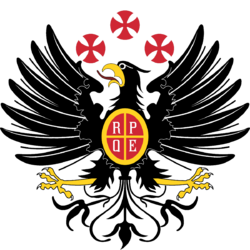 | |
| Armiger | United Etrurian Federation |
| Adopted | 1888 |
| Crest | None |
| Torse | None |
| Blazon | Gules, a Fasces surrounded by on the dexter, a wreath of laurel, and to the sinister, a wreath of Oak, over all a wide pelte shield, led by an eagle-head on the dexter and sinister with the blazon of "RE", all Or. |
| Supporters | A Eagle of Trasimene in sable. |
| Motto | None |
| Orders | None |
The Emblem of Etruria (Vespasian: Stemma D'Etruria) is the national emblem of Etruria. Adopted by the Etrurian Second Republic in wake of the San Sepulchro Revolution in 1888, it comprises the Eagle of Trasimene, crested by three black stars to represent the "three peoples of Etruria" and is blazoned by a shield containing the "Emblem of the Republic" (Emblema della Repubblica), a fasces flanked by oak and a wreath of laurel, and blazoned in turn by a pelte shield which hosts the monogram "RE" for Reppublica Etruriana. Having been in near continuous use from 1888 (with the exception of the period of 1938-1946), the current coat of arms is the one longest used by the Etrurian state.
Design
The principal feature of the coat of arms is the Eagle of Trasimene, a black eagle. The Eagle of Trasimene was reportedly used by the low-ranking aristocratic Sadano family, who were among the first to denounce the excesses and authoritarianism of the Etrurian monarchy, it was then used as a standard by revolutionaries in 1888, following the widespread rumour that the Sadano family had been murdered by order of Prime Minister Girolamo Galba. The widespread prevelance of the Eagle of Trasimene resulted in its adoption as a symbol of renewed republicanism in Etruria. The eagle is crowned with three black stars, each representing the "peoples of Etruria", Vespasians, Novalians and Carinthians. THe three stars have also been seen to represent the original ideals of the Etrurian First Republic, "God, Fraternity and Liberty" (Deo, Fraternitas, Libertas).
The Eagle of Trasimene is emblazoned by a red shield which holds within it, the "Emblem of the Republic" (Emblema della Repubblica). The emblem is comprised of a wide pelte shield with, on both ends eagle-heads, bearing a monogram "RE" standing for Reppublica Etruriana (Etrurian Republic). The emblem is bounded by an olive branch, symbolising peace, and an oak branch, symbolising the wisdom of democracy. Centrally placed is the fasces, a symbol long associated with republicanism and justice.
Usage
As per the Etrurian constitution, the emblem is to be used by government agencies of Etruria, on government buildings, government documents, messages, and on banknotes and coins of the Etrurian florin. The emblem is also present on the Flag of Etruria, located at the centre of the white bar.
Historic coat of arms of Etruria
Previous versions
| Period | Coat of arms | Description and blazon | Dates used |
|---|---|---|---|
| Etrurian First Republic | 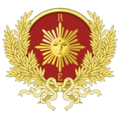
|
The first coat of arms adopted by the Etrurian Republic in wake of the execution of Prince Alessandro III during the early stages of the Etrurian Revolution, was drawn from proposals that circulated among members of the Society of Master Builders (Società dei Maestri Costruttori), a secret society that advocated for democracy and liberalism during the 1760s. Their dominance of the Constiuent Assembly led to the acceptance of the proposal by Caio Aurelio della Portata. The circular shield was flanked by two laurel wreaths and was emblazoned by the Face of Sol, a sun bearing the face of the supreme deity of Ancient Solaria. At the top of the northern ray was the letter "R" for Reppublica (Republic) and to the bottom, below the southern ray was the letter "E" for Etruriana (Etrurian). The adoption of the "Sol emblem" (Emblema Sol), was one of the earliest causes of division among the revolutionaries, with the Patheonisti condemning it as "pagan." The coat of arms was abandoned following the Reaction of the Pantheon, which resulted in the overthrow of the constituent assembly by the Pantheonisti and the establishment of the Republic of Heaven.
The first emblem would remain synonymous with secret societies in Etruria for centuries, while in the modern day, it became a popular symbol for the northern states of Etruria, where many of the Pantheonisti-Republic's enemies fled to and resisted. |
1784-1785 |
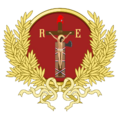
|
The second emblem of the First Republic was adopted in wake of the Reaction of the Pantheon and would be the principal symbol of the early Republic of Heaven period. The second coat of arms, designed by Fr. Emilio Ochetti, merely replaced the Face of Sol with a coloured image of the crucifixion, crowned by a phyrgian cap, which held a cockade. The crucifixion was flanked to the left by the letter "R" and to the right, the letter "E", both representing "Reppublica Etruriana" (Etrurian Republic). Notably, the cross replaced the axe of the fasces, with the crucifixion being interepreted to be "the true tie that binds the free." The second iteration maintained the wreath laurels as supporters. The popularity of the second coat of arms was widespread, especially with lower-classes. The Pantheonisti saw the second as the truest manifestation of their religious republicanism, who wished to replace monarchism and monarchs with Sotirias. | 1785-1790 | |

|
The third emblem adopted by the First Republic, was introduced in 1790 was the Etrurian Revolutionary Wars began to turn toward a bloody stalemate. The Republic began to place the Virgin Mary as a major propaganda element, but she also became a central figure for the families of the mass conscripts. Her role in being the "Lady of Clemency" (Signora della Clemenza) to many Etrurian Catholics, resulted in the Virgin Mary being a symbol for many to pray for the safety, protection and return of the soldiers fighting monarchies abroad. Hoping to capitalise on this outpouring of Marian veneration, the Republic replaced the Crucifixion-based coat of arms with a new lasting iteration, merging the image of the Virgin Mary with elements of their revolutionary religious republicanism. The third iteration comrpises a golden console, flanked by branches of laurel wreaths. Inside on a field a red, is the Virgin Mary in a white tunic and wearing a blue cloak. She sits before a a field of sun rays, holds a white rose representing "purity of spirit." Her blue cloak also hosts an Etrurian cockade, presenting a "divine blessing of the revolution." The Virgin Mary stands atop a white crescent moon, symbolising the "conquering of ignorance" and also a green snake, both representing satan and monarchism. The third emblem would remain in use until the Caltrini Restoration and the overthrow of the Republic in 1810. | 1790-1810 | |
| United Kingdom of Etruria | 
|
The coat of arms adopted by the United Kingdom of Etruria in wake of the Caltrini Restoration in 1810, was markedly different to other coats of arms found in monarchies across Euclea. In an effort to pay homage to the republicanism of the Revolution and to deter opposition to the return of monarchism, the new coat of arms was absent of any reference to the House of Caltrini. Instead, the coat of arms adopted symbols of key regions of the Kingdom. The shield is comprised of from top-left clockwise: the Keys and parasol of Solaria, to reflect its Papal history, the crowned sea dragon of the Solarian Sea, the winged lion of Povelia, wearing a phyrgian cap, the historic coat of arms of Novalia and the crowned eagle of Carinthia. At the centre is a shield containing an image of the Virgin Mary to reflect the country's Catholicism. Some verions of the emblem include the Crown of Saint Vittore, though this was used solely for royal correspondence or documents and was never displayed publicly. Between 1849 and 1888, during the height of the monarchy's popularity and its decline, the royal coat of arms were more officially adopted. | 1810-1849 |

|
The second coat of arms adopted by the Kingdom was a simplified form of the Royal Coat of Arms of House Caltrini. The family herald shield was blazoned with the crowned eagle of Carinthia, the Cross of Novalia's Saints and the winged lion of Povelia, though with its republican phyrgian cap removed. The Crown of Saint Vittore sits atop the shield. It would be banned and its display criminalised in wake of the San Sepulchro Revolution of 1888, by the Etrurian Second Republic. Today, it is widely used by monarchist and far-right groups in Etruria. | 1849-1888 | |
| Etrurian Second Republic | 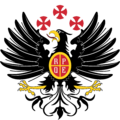
|
The current coat of arms, was first adopted in 1888, in wake of the San Sepulchro Revolution. The principal feature of the coat of arms is the Eagle of Trasimene, a black eagle. The Eagle of Trasimene was reportedly used by the low-ranking aristocratic Sadano family, who were among the first to denounce the excesses and authoritarianism of the Etrurian monarchy, it was then used as a standard by revolutionaries in 1888, following the widespread rumour that the Sadano family had been murdered by order of Prime Minister Girolamo Galba. The widespread prevelance of the Eagle of Trasimene resulted in its adoption as a symbol of renewed republicanism in Etruria. The eagle is crowned with three black stars, each representing the "peoples of Etruria", Vespasians, Novalians and Carinthians. THe three stars have also been seen to represent the original ideals of the Etrurian First Republic, "God, Fraternity and Liberty" (Deo, Fraternitas, Libertas). The Eagle of Trasimene is emblazoned by a red shield which holds within it, the "Emblem of the Republic" (Emblema della Repubblica). The emblem is comprised of a wide pelte shield with, on both ends eagle-heads, bearing a monogram "RE" standing for Reppublica Etruriana (Etrurian Republic). The emblem is bounded by an olive branch, symbolising peace, and an oak branch, symbolising the wisdom of democracy. Centrally placed is the fasces, a symbol long associated with republicanism and justice. The "Eagle of Trasimene" arms were used by the Second Republic, Third Republic (1948-1960) and from 1984 to the present day. | 1888-1938 1946-1960 1984-present |
| Greater Solarian Republic | 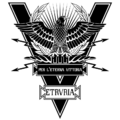
|
1938-1946 | |
| Etrurian military dicatorship | 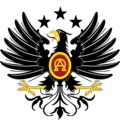
|
